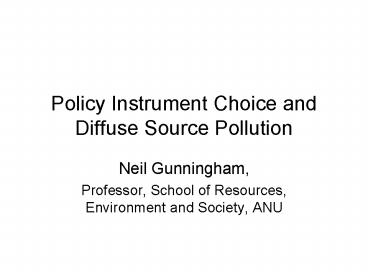Policy Instrument Choice and Diffuse Source Pollution - PowerPoint PPT Presentation
1 / 22
Title:
Policy Instrument Choice and Diffuse Source Pollution
Description:
Eg Swan-Canning Cleanup program. Riverplan. Local community bodies ... At no point in the Swan Action Plan is there any indication that non-point ... – PowerPoint PPT presentation
Number of Views:20
Avg rating:3.0/5.0
Title: Policy Instrument Choice and Diffuse Source Pollution
1
Policy Instrument Choice and Diffuse Source
Pollution
- Neil Gunningham,
- Professor, School of Resources, Environment and
Society, ANU
2
Non-Point Source Pollution from agriculture
policy challenges
- Many different contributors to NPSP, spread over
a large geographical area - on the ground inspection largely impractical
- NPSP very difficult to measure and track to its
source - Impact of agricultural practices varies greatly
between properties and areas - Agricultural enterprises limited awareness,
knowledge, resources, and resistant to regulation
3
Key Issues
- What to target?
- -inputs or practices known to lead to pollution
- -emission proxies etc
- -ambient pollution
- Who to target?
- the impacter
- drain managers
- others
4
In broad terms
- Impact of State legislation and local government
on NPSP very limited because these powers either - -prospective in nature
- -establish a pollution threshold too high to
capture diffuse sources - -provide inadequate regulatory or enforcement
powers
5
The result
- Current policy focuses on strategic policy
development and associated education programs - Eg Swan-Canning Cleanup program
- Riverplan
- Local community bodies
- All underpinned by variety of education and
information programs eg Heavenly Hectares
6
Past Policy
- Heavy reliance on information and education
- Heavy reliance on voluntarism
7
Eg The Swan-Canning
- on-ground works by community and catchment
groups, - public education,
- ongoing research and monitoring and
- a number of scientific and engineering projects
- At no point in the Swan Action Plan is there
any indication that non-point sources are likely
to be regulated or licensed, with most effort
being aimed at education and information
provision and cost-sharing assistance for
voluntary on-ground works (Gordon)
8
Why does exhortation fail?
- Gap between public and private interest is large
- Limits of appeal to do the right thing
- Perceptions that its someone else who is causing
it - Its hard to be green while youre in the red
- Perceptions that others are getting away with
it
9
20 percent of the population will comply with
any regulation, 5 percent will attempt to evade
it, and the remaining 75 percent will go along
with it as long as the 5 percent were caught and
punished
10
Where next?Preliminary Steps
- Identifying causes (eg reducing risk from
fertilisers, changing land uses, buffer zones,
replanting, perennial crops) - Establishing targets
- -individual management targets (X with buffers)
- -management practice targets (Y with
environmental farm plans) - -catchment/sub-catchment targets
- Assessment criteria efficiency, effectiveness,
equity, political acceptability
11
Key questions What compliance mechanism(s) to
invoke
- Voluntarism, education and information
- Positive incentives
- Negative incentives
- Mandatory controls/regulation
12
What type of standards to employ?
- Performance standards
- Specification/technology standards
- Process (management-based) standards
13
Where to target?
- Farm Management Practices
- Landscape Changes
- Land Use Patterns
14
Farm Management Practices
- Process Standards- eg environmental farm plans,
BMPs, EMS, Codes of Practice - Environmental farm plans include farm
description, issue assessment, design of works
program or action plan, etc - Fertiliser management plan level of application,
when to apply, where to apply.
15
How to achieve compliance?
- Voluntarism?
- Positive incentives subsidies/ rate rebate
- Negative incentive cross compliance, BMP
incentive charges. - Mandatory regulation- eg Netherlands and Nutrient
sensitive areas - The role of check-lists and self-audit
- How do the above rate in terms of evaluation
criteria?
16
Business inputs
- Taxes on fertiliser or pesticide use
- Mandatory quotas or bans
17
Landscape Changes
- Landscape changes include fencing, buffer strips,
re-vegetation, riparian zones a, contour
landscaping, soil modification etc - Specification standards easy to monitor and
enforce
18
Which compliance mechanism
- Voluntarism?
- Positive incentives- financial subsidy, NHT cost
sharing programs, or auctioned grants - Mandatory changes (eg buffer zones)
- How to the above rank in terms of evaluation
criteria?
19
Land Use Patterns
- shaping the location and type of farm activities
that take place across an entire
catchment/sub-catchment - Planning Law
- -enables coordinated approach and common
standards state, local, regional - -eg state or regional plans, local zoning
requirements but confined to prospective
activities - Assessment in terms of policy criteria?
20
Subsidies, Mandatory Controls and Compensation
- Subsidies targeted at farmers in pollution hot
spots to adopt different land management
practices - Mandatory controls- cf native veg (again limited
to hot spots) - Compulsory purchase?
- Assessment in terms of policy criteria
21
A phased approach?
- Dangers of a smorgasbord approach and of single
instrument approaches - Build in responsiveness and principles of
adaptive management - Place different weight on different policy
criteria depending upon external circumstances
22
A phased approach?
- The need for trade offs effectiveness,
efficiency, equity and political acceptability - Phase 1 positive incentives (process standards,
landscape changes) and planning controls - Phase 2 negative incentives and regulation
- - environmental general duty to the land,
- enforced through mandatory self-auditing and
random third party audits) - mandatory specification standards (eg buffer
zones) - levy or sliding charge re adoption of env farm
plan






























